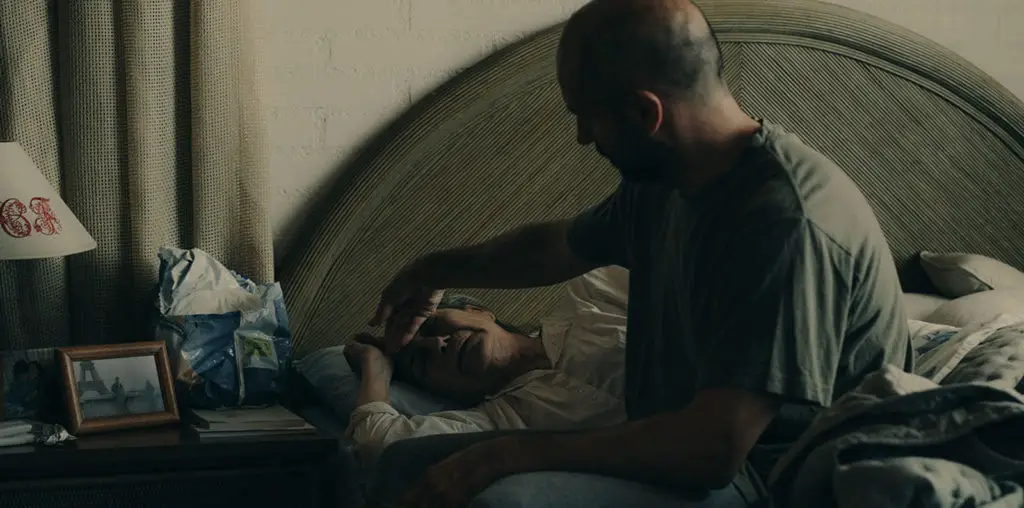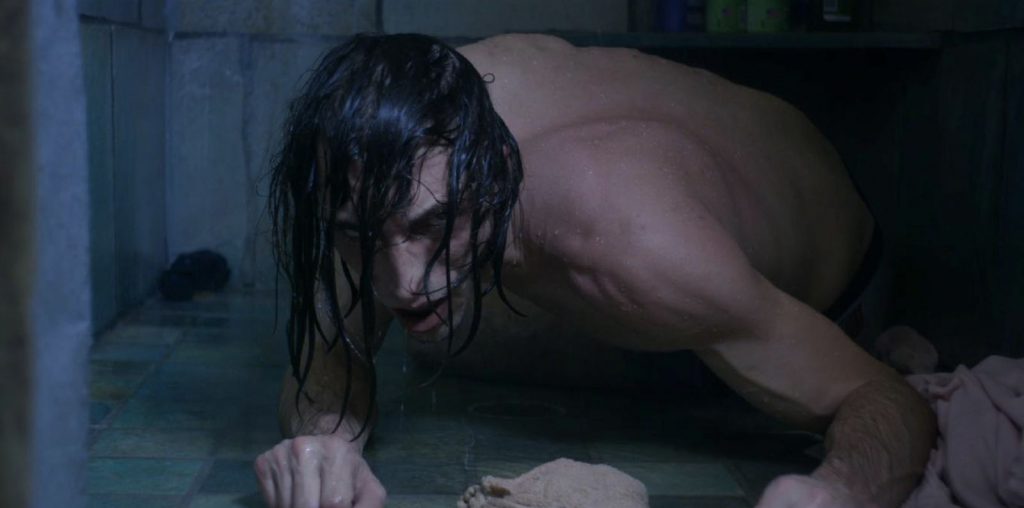
“Squeal like a pig,” insists knife-wielding, hillbilly sodomite Billy McKinney as he hunches over Bobby (Ned Beatty), a naïve, mortified city slicker. A shotgun’s length away, another backwoods cracker (Herbert “Cowboy” Howard) drools over Ed (Jon Voight) – his reluctant date for the afternoon – who’s belted snugly onto a tree and melting in terror. With pudgy face slammed into dirt and leaves, Bobby complies with McKinney’s instructions. “Squee! Squee! Squee – augh!”
The ensuing rape scene from John Boorman’s infamous “Deliverance” remains one of cinema’s most brutal endurance tests, often copied (Pulp Fiction, Irreversible,) but never duplicated. Ditto for the rest of this sensational suspense classic, which, sadly, has come to be known more as the punch line for sodomy jokes than for being a great movie (In fact, onscreen baddie McKinney has even unveiled his own web site: www.squeallikeapig.com).
“Deliverance” was recognized upon its 1972 release with decent box-office receipts (according to the IMDB, $22 million in the U.S. to date) and a trio of Oscar Nominations. Even so, Boorman’s tense masterpiece had the misfortune of being released the same year as “The Godfather,” and consequently overlooked in the wake of Coppola’s legendary mob classic. Any other year, ensemble acting would have been defined by the “Deliverance” crew, and not Pacino, Duvall, Brando, Caan, and Cazale.
Burt Reynolds’ career has since plummeted down a set of rapids far more damaging than anything the actor navigated in Georgia (“Cop and a Half,” anyone?), but it’s hard to imagine anyone better for the part of Lewis, a pumped-up, swaggering renaissance man who guides this brigade of greenhorns into the Appalachian heart of darkness first conjured up by James Dickey (who plays a sheriff in the final scenes of “Deliverance”) in his 1970 novel. Lewis is the kind of charismatic blowhard whose persuasive gusto makes him both a natural leader, and a reckless disaster magnet. Perhaps magnifying his performance as a powerful man turned helpless subordinate, Reynolds fractured his tailbone during the hairy, waterlogged shoot.
Jon Voight plays the pivotal role of Ed, a seemingly fragile man who weathers crisis by morphing violently into an aggressive pursuer. According to production notes included in the film’s DVD, Voight completed a treacherous cliff-climb without insurance coverage (no company was willing to take on the risky shoot). Rising even above his stellar work in “Midnight Cowboy” and “Coming Home,” Voight has never been better. Balloon-lipped daughter Angelina Jolie might get all the attention these days, but as “Deliverance” reminds us, father Jon was the first family member acknowledged for having “a real pretty mouth.”
Even Beatty and Ronny Cox, playing the more passive secondary players in this river-running quartet, play gregarious, violated wise-a*s Bobby and peace-loving folkie Drew for all they’re worth. (It’s a testimonial to Cox’s acting chops that he would ride a second wave of fame as “Robocop” villain Dick Jones, the cold, corporate antithesis of everything Drew represented.)
Great acting and characterizations aside, it’s Boorman’s use of ambiguity to raise an audience’s hackles that makes “Deliverance” unique. Today, movies attempt to clarify each and every character action. “Deliverance,” however, boasts a handful of vague plot progressions that prompt heated chat-room debates even today, thirty years after its initial theatrical run. Not convinced? Then put down your moonshine and take a dadburned minute to consider the following.
Ongoing “Deliverance” debate number one: Following the film’s big rape scene, macho, bow-wielding Alpha Male Lewis (Burt Reynolds) shoots McKinney’s evil chubby-chaser in the back, killing him. The group of four ill-fated urbanites are left to make a decision: do they report the death to authorities, or bury the body and keep their deed a secret? After the latter choice is made, guitar-strumming pacifist Drew (Ronny Cox) defiantly argues that “this is a matter of the law.” The group quickly buries its attacker and high-tails it down the river in canoes, leading to Boorman’s first argument-inducing mystery scene. Approaching the headwaters of a treacherous white- water chute, the canoe convoy is distracted by Drew’s sudden forward tumble out of his vessel and into the swift current. Was Drew shot by the second mountain man, who escaped the rape site and hurriedly hot-footed it into the woods? Was Drew emotionally distraught by the group’s decision to bypass legal channels and deny the crossbow murder, to the point of dizzy-headed delirium? Was his fall from the canoe an intentional suicide gesture? The world may never know, unless Boorman contributes a clarifying director’s commentary to some future “special edition” DVD.
Ongoing Deliverance debate number two: Equally effective is another white-knuckler where Ed (Jon Voight), goes from nervous Nelly to natural born killer, while group leader Lewis is incapacitated by a femur-mangling plummet down the rapids. After ascending a cliff and killing a second okie hillbilly, Ed is momentarily unsure whether or not he’s shot the right man. Even to this day, husbands and wives fight over the scene, bickering as to whether or not Ed’s target was, indeed, the “toothless man” of the rape scene, or merely a passing hilltop hunter. The way Boorman presents his grimy backwoods cadavers, it’s tough to tell, even with persistent DVD freeze-framing, though popular consensus suggests that the corpse does, in fact, belong to Herbert “Cowboy” Howard, the second redneck rapist from earlier in the film.
For those who need to put a clear-cut lid on such things, “Deliverance” might seem a maddening ride. But these foggy occurrences create a “Rashomon”-like subjectivity to this unique viewing experience that reflects the messy loose ends of real life. Maybe that DVD commentary isn’t such a great idea, after all.
One could also give kudos to Boorman’s willingness to take on male rape as a serious cinematic subject (“Deliverance” is allegedly viewed by convicted sex offenders in some correctional programs, used as an empathy tool and hopeful deterrent to future deviance), or to the creepy foreboding created by his casting of genuine Appalachian country bumpkins as extras.
In any event, “Deliverance” warrants a DVD resurrection beyond the rather generic Warner Home Video version originally released in 1999 (and re-released in 2003). Although its vivid colors and widescreen format offer a superior contrast to the grimy pan and scan versions found on television and in earlier video transfers, there’s precious little extra, aside from an underwhelming, ten minute documentary (“The Dangerous World of Deliverance”) and theatrical trailer. Why couldn’t Warner have thrown in the much-rumored cut scene where Sheriff Dickey shows a body to the three remaining river-runners? (Supposedly, the corpse’s face is never shown, leaving audiences to guess whether it belongs to Drew or one of the villainous hillbilly buddies, in another clever instance of Boorman-patented vagueness.) Where’s the interview with Dickey concerning volatile arguments breaking out between he and Boorman during the heated shoot? Perhaps Reynolds could have elaborated on a tale told in his autobiography (1994’s “My Life), in which Howard, after being told his role involved raping a man, nonchalantly responded, “I done worse.”
With a little fan insistence, perhaps this squeaky wheel (or rather, “squealing pig”) will get some grease – and the bells ‘n whistles DVD treatment it deserves.
KJ Doughton resurrects reels and breathes life back into films currently on life support and verging on extinction. Applying his “rave resuscitation” to movies at risk of fading into obscurity due to old age, faltering promotional systems, premature delivery, societal stigma, or a runty box-office take, he advocates a second chance for flat-lining films too important to die.

